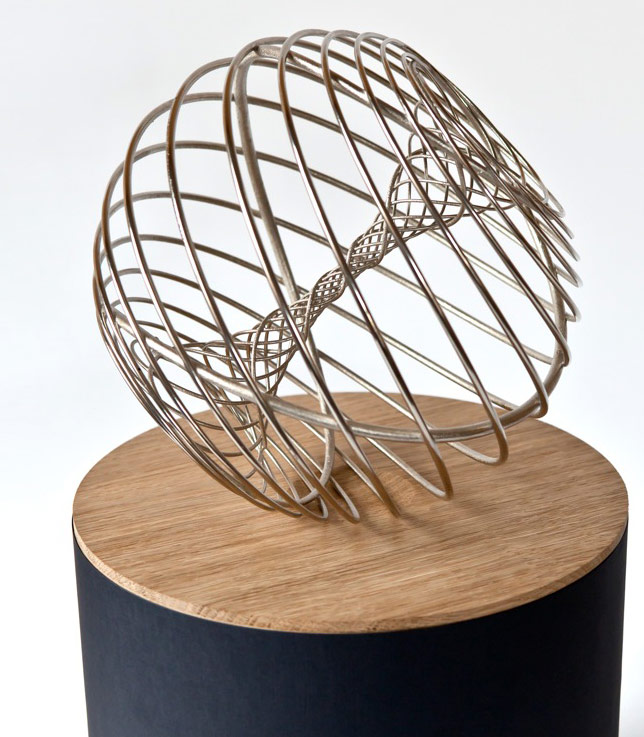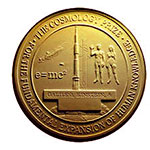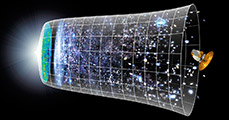
Wilkinson Microwave Anisotropy Probe
The Wilkinson Microwave Anisotropy Probe (WMAP) is a NASA Explorer mission that launched June 2001 to make fundamental measurements of cosmology -- the study of the properties of our universe as a whole. WMAP has been stunningly successful, producing our new Standard Model of Cosmology. WMAP's data stream has ended. Full analysis of the data is now complete. Publications have been submitted as of 12/20/2012.
WMAP Team Receives the 2018 Breakthrough Prize
 "WMAP wins the Fundamental Physics Award for detailed maps of the early universe that greatly improved our knowledge of the evolution of the cosmos and the fluctuations that seeded the formation of galaxies."
"WMAP wins the Fundamental Physics Award for detailed maps of the early universe that greatly improved our knowledge of the evolution of the cosmos and the fluctuations that seeded the formation of galaxies."
The prize is awarded to Charles L. Bennett, Gary Hinshaw, Norman Jarosik, Lyman Page Jr., David N. Spergel, and the 27 member WMAP Science Team.
For more information about the prize visit: 2018 Breakthrough Prize - Fundamental Physics - Laureates
WMAP Team Receives the 2012 Gruber Cosmology Prize
 "The Gruber Foundation proudly presents the 2012 Cosmology Prize to Charles Bennett and the Wilkinson Microwave Anisotropy Probe team for their exquisite measurements of anisotropies in the relic radiation from the Big Bang---the Cosmic Microwave Background. These measurements have helped to secure rigorous constraints on the origin, content, age, and geometry of the Universe, transforming our current paradigm of structure formation from appealing scenario into precise science."
"The Gruber Foundation proudly presents the 2012 Cosmology Prize to Charles Bennett and the Wilkinson Microwave Anisotropy Probe team for their exquisite measurements of anisotropies in the relic radiation from the Big Bang---the Cosmic Microwave Background. These measurements have helped to secure rigorous constraints on the origin, content, age, and geometry of the Universe, transforming our current paradigm of structure formation from appealing scenario into precise science."
Other Members of the WMAP team are:
Chris Barnes, Rachel Bean, Olivier Doré, Joanna Dunkley, Benjamin M. Gold, Michael Greason, Mark Halpern, Robert Hill, Gary F. Hinshaw, Norman Jarosik, Alan Kogut, Eiichiro Komatsu, David Larson, Michele Limon, Stephan S. Meyer, Michael R. Nolta, Nils Odegard, Lyman Page, Hiranya V. Peiris, Kendrick Smith, David N. Spergel, Greg S. Tucker, Licia Verde, Janet L. Weiland, Edward Wollack, and Edward L. (Ned) Wright.
For more information about the prize: 2012 Gruber Cosmology Prize Press Release For more information about the WMAP Team: Charles Bennett and the WMAP Team
|
WMAP's Top Ten
The WMAP science team has…
|
The End of the Beginning"The last word from WMAP marks the end of the beginning in our quest to understand the Universe. WMAP has brought precision to cosmology and the Universe will never be the same." -Adam Riess, recipient of the 2011 Nobel Prize in physics
Steven Hawking"Stephen Hawking recently told New Scientist that WMAP's evidence for inflation was the most exciting development in physics during his career." WMAP Awarded Gruber Prize"WMAP has had a transformative impact on the field of cosmology. It provided strong confirmation of our basic picture of the universe and added unprecedented precision. It is the benchmark for almost every other cosmological measurement and sets a very high bar for future experiments." WMAP mission scores 'world's most cited' in science pubs"WMAP results were among the most-cited scientific papers in the world across all scientific disciplines [in 2011], not just in physics and astronomy. It also happened in 2003, 2007 and 2009. This time WMAP captured the first, second and third spots in the rankings in a single year—a science trifecta." THE RED-HOT RESEARCH PAPERS OF 2011"Achieving particular distinction atop the list are three reports from the Wilkinson Microwave Anisotropy Probe (WMAP), launched in 2001. ... Paper #1 in the table, delivering the "cosmological interpretations" of the WMAP seven-year data, had already been cited more than 500 times before the end of its first year of publication." "Every astronomer will remember the moment he heard the results from WMAP." "Before the WMAP results, astronomers and physicists had put together a very implausible picture of our universe. It had a tiny amount of ordinary matter. It had a modest amount of dark matter, whatever that is. It had an overwhelming amount of dark energy, which is a strange beast. I have to confess I was very skeptical of this picture. But the WMAP results have convinced me." "The announcement today represents a rite of passage for cosmology from speculation to precision science." - John Bahcall of the Institute for Advanced Study in Princeton, N.J.
"WMAP is the instrument that finally allowed scientists to hear the celestial music and figure out what sort of instrument our cosmos is... WMAP has nearly perfect pitch." "It ends a decades-long argument about the nature of the universe and confirms that our cosmos is much, much stranger than we ever imagined." "All the arguments of the last few decades about the basic properties of the universe—its age, its expansion rate, its composition, its density—have been settled in one fell swoop." The precise and accurate WMAP result is "now the frame of reference for all cosmological investigations." It "dramatically shrinks the volume of parameter space that describes our
"In a sentence, the observations are spectacular and the conclusions are stunning," said Brian Greene of Columbia University in New York City. "WMAP data support the notion that galaxies are nothing but quantum mechanics writ large across the sky." "To me, this is one of the marvels of the modern scientific age."
|


